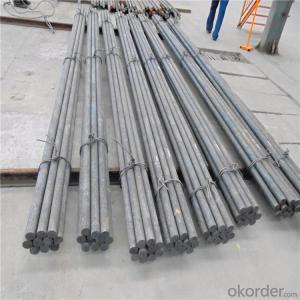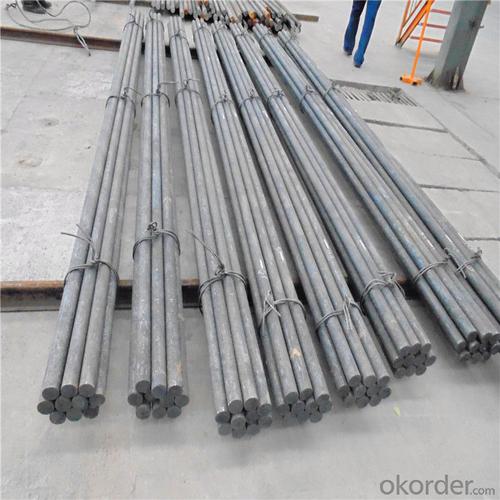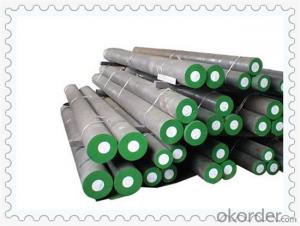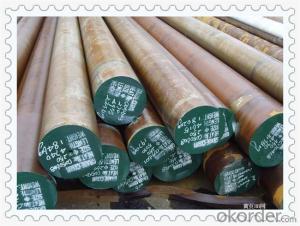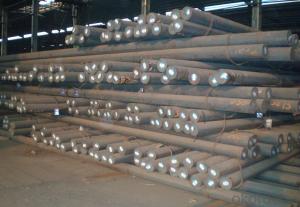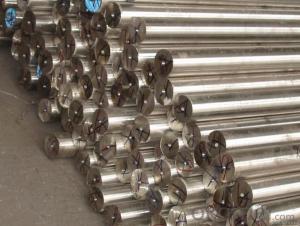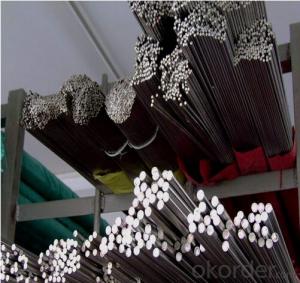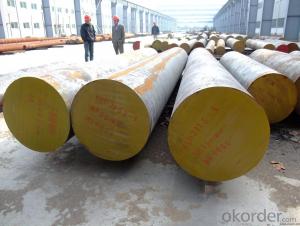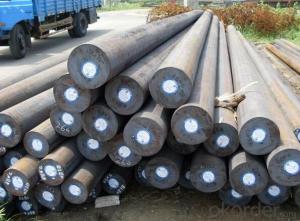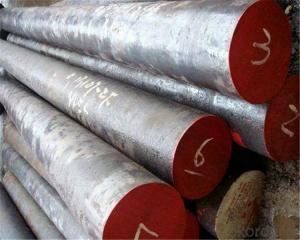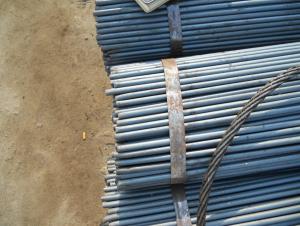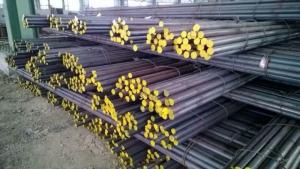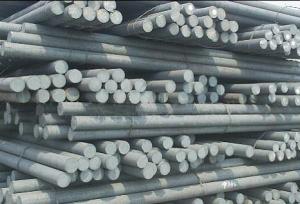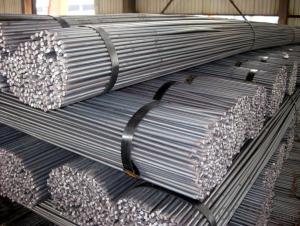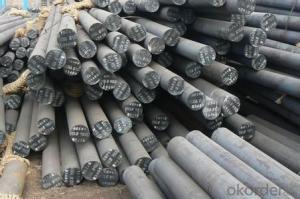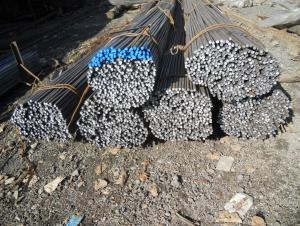Hot Forged Tool Steel Round Bar D-2, 42crmo4, ASTM A681, DIN 1.2379, SAE J437, J438
- Loading Port:
- Tianjin
- Payment Terms:
- TT OR LC
- Min Order Qty:
- 100 m.t.
- Supply Capability:
- 500000 m.t./month
OKorder Service Pledge
OKorder Financial Service
You Might Also Like
Specification
Hot Forged Tool Steel Round Bar D-2, 42crmo4, ASTM A6
Product Description of Hot Forged Tool Steel Round Bar D-2, 42crmo4, ASTM A6
1. Steel grade: ASTM4140, SCM440, 42CrMo, DIN1.7225
2. Length: 6M-12M
3. Diameter: 16mm-300mm
4. Product range: round bar, flat bar, square bar
5. Technique: Hot rolled, forged, cold drawn
Specification of Hot Forged Tool Steel Round Bar D-2, 42crmo4, ASTM A6
Material | SCM4140 | Round bar | Dia(mm) | 16-300mm |
Process | EAF + LF + VD + Forged + Heat Treatment (optional) | Length (mm) | Max 12m | |
Heat treatment | Normalized / Annealed / Quenched / tempered | Flat bar | Thickness(mm) | 8-500mm |
Delivery condition | Hot forged +Rough machined (black surface after Q/T)+ Turned (optional) | Width(mm) | 70-200mm | |
Test | Ultrasonic test according to SEP 1921-84 D/d | Length (mm) | Max 12m |
Chemical Composition of Hot Forged Tool Steel Round Bar D-2, 42crmo4, ASTM A6
C | Si | Mn | Cr | Mo | P | S |
0.38~0.43 | 0.15~0.35 | 0.75~1.00 | 0.8~1.1 | 0.15~0.25 | ≤0.035 | <0.04< td=""> |
Photo Show of Hot Forged Tool Steel Round Bar D-2, 42crmo4, ASTM A6
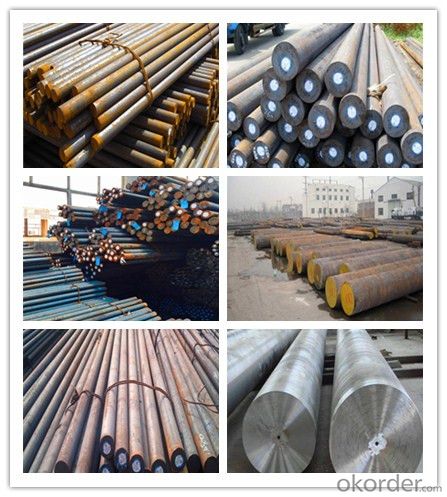
Packing and Delivery:
Packing in bundle package, or as customer's requirements.
Delivery Detail: 45 days after receiving the deposit.
Usage and Applications of Hot Forged Tool Steel Round Bar D-2, 42crmo4, ASTM A6
1. Steel round bar is used in a large number of architectural and engineering structures. Or it can be used in construction of plants for the production of steel house frames, high-voltage transmission towers, bridges, vehicles, boilers, containers, ships, etc.
2. And we can use this kind of product on the performance of the mechanical parts if the demand is not very high.
3. Some special material steel round bar can be used for main shaft of steamer, hummer shank, with big section and supper force.
Company Information
CNBM International Corporation is the most important trading platform of CNBM group.
Whith its advantages, CNBM International are mainly concentrate on Cement, Glass, Iron and Steel, Ceramics industries and devotes herself for supplying high qulity series of refractories as well as technical consultancies and logistics solutions.

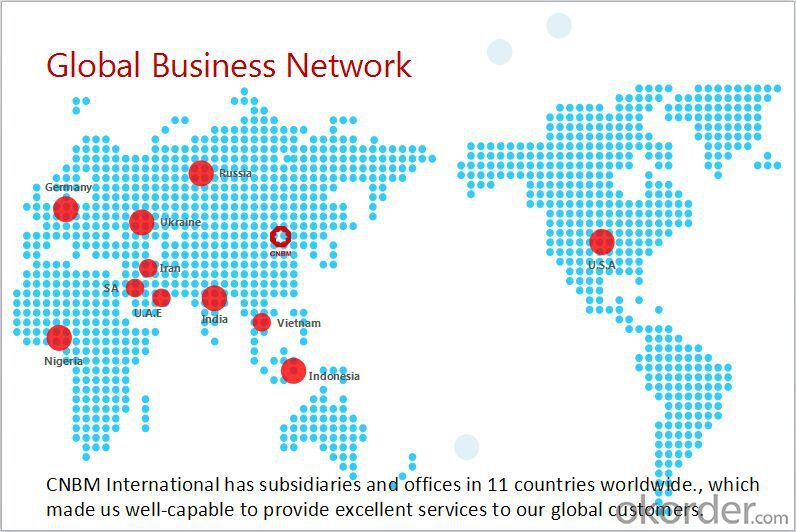
F A Q
1, Your advantages?
professional products inquiry, products knowledge train (for agents), smooth goods delivery, excellent customer solution proposale
2, Test & Certificate?
SGS test is available, customer inspection before shipping is welcome, third party inspection is no problem
3, Factory or Trading Company?
CNBM is a trading company but we have so many protocol factories and CNBM works as a trading department of these factories. Also CNBM is the holding company of many factories.
4, Payment Terms?
30% TT as deposit and 70% before delivery.
Irrevocable L/C at sight.
5, Trading Terms?
EXW, FOB, CIF, FFR, CNF
6, After-sale Service?
CNBM provides the services and support you need for every step of our cooperation. We're the business partner you can trust.
For any problem, please kindly contact us at any your convenient time.
We'll reply you in our first priority within 24 hours.
- Q: Can steel round bars be used for structural purposes?
- Yes, steel round bars can be used for structural purposes. They are commonly used in the construction industry for various applications, such as providing support and reinforcement in buildings, bridges, and other structures. The high strength and durability of steel make round bars an ideal choice for structural use, as they can withstand heavy loads and provide stability.
- Q: What is the difference between a centerless ground and a rough turned steel round bar?
- A centerless ground steel round bar and a rough turned steel round bar differ in terms of their manufacturing processes and resulting surface finishes. A centerless ground steel round bar is produced by feeding the bar through a grinding machine that removes material from the surface to achieve precise diameter and roundness tolerances. This process involves rotating the bar between two grinding wheels while applying pressure to remove any imperfections and create a smooth, polished surface finish. The end result is a highly accurate and consistent diameter with a mirror-like finish, making it suitable for applications that require tight tolerances and a polished appearance. On the other hand, a rough turned steel round bar is manufactured through a different machining process called turning. This involves rotating the bar against a cutting tool that removes material from the surface in order to achieve the desired diameter and shape. However, unlike centerless grinding, turning does not provide the same level of precision and surface finish. The resulting surface of a rough turned bar will have visible tool marks and a rougher texture compared to a centerless ground bar. In summary, the main difference between a centerless ground steel round bar and a rough turned steel round bar lies in their manufacturing processes and resulting surface finishes. Centerless grinding offers a more precise diameter, roundness, and smoother surface finish, making it ideal for applications that require tight tolerances and a polished appearance. Rough turning, while less precise and with a rougher surface finish, is still suitable for applications that do not require the same level of precision or aesthetic appeal.
- Q: What are the advantages of using nickel-titanium alloy steel round bars?
- There are several advantages of using nickel-titanium alloy steel round bars. Firstly, this alloy offers high strength and excellent corrosion resistance, making it suitable for various applications in industries such as aerospace, automotive, and medical. Additionally, nickel-titanium alloy steel has shape memory properties, allowing it to return to its original shape after deformation, making it ideal for applications requiring repeated bending or twisting. Furthermore, this alloy exhibits superelasticity, meaning it can withstand large amounts of strain without permanent deformation, providing enhanced durability and longevity. Overall, the unique combination of strength, corrosion resistance, shape memory, and superelasticity makes nickel-titanium alloy steel round bars a versatile and advantageous material choice.
- Q: What is the tolerance for length in steel round bars?
- The tolerance for length in steel round bars can vary based on specific manufacturing standards and requirements. Typically, the tolerance is defined as the maximum allowable deviation from the desired length and can be expressed as a percentage or specific measurement in millimeters or inches. Various international standards organizations, such as ASTM or ISO, may have their own guidelines for steel round bar tolerances. These standards ensure consistent and reliable measurements across the industry. In practice, tolerances for steel round bar length can range from tight tolerances of a few millimeters for precision applications to looser tolerances of several centimeters for general-purpose use. It is important to consider that the tolerance may also depend on the size and diameter of the bar. Smaller diameter bars may have tighter tolerances due to the challenges in manufacturing and accurately measuring longer lengths. Ultimately, the specific tolerance for steel round bar length should be determined based on the intended application and relevant industry standards or customer specifications.
- Q: How do you determine the straightness of a steel round bar?
- To determine the straightness of a steel round bar, there are several methods that can be used. One common method is visual inspection, where the bar is carefully examined for any visible bends, twists, or deviations from a straight line. This can be done by placing the bar on a flat surface and checking for any gaps or unevenness between the surface and the bar. Another method is to use a straightedge or a precision ruler. By placing the straightedge or ruler along the length of the bar, any deviations from a straight line can be easily detected. This method allows for more precise measurements and can help identify even slight bends or curves. Measuring devices such as dial indicators or laser alignment tools can also be used to determine the straightness of a steel round bar. These devices provide more accurate measurements and can quantify the degree of straightness by providing numerical readings of any deviations from a straight line. It is important to note that the acceptable level of straightness may vary depending on the specific application or industry standards. In such cases, specific tolerances or guidelines may need to be followed to ensure that the steel round bar meets the required straightness criteria. Overall, determining the straightness of a steel round bar requires careful visual inspection and the use of appropriate measuring tools to ensure that it meets the necessary straightness standards for its intended use.
- Q: What is the red hardness of a steel round bar?
- The red hardness of a steel round bar refers to its ability to maintain its hardness and resistance to deformation at high temperatures. It is a measure of how well the steel can retain its strength and hardness when exposed to heat. Generally, steels with higher carbon content exhibit higher red hardness. This property is particularly important in applications where the steel is subjected to elevated temperatures, such as in forging or heat-treating processes. The red hardness of a steel round bar can be determined through various tests and measurements, such as hardness testing at different temperatures or by evaluating the steel's microstructure.
- Q: Can steel round bars be used in the oilfield equipment industry?
- Yes, steel round bars can be used in the oilfield equipment industry. Steel round bars are commonly used in the oilfield industry due to their high strength, durability, and resistance to corrosion. They are used to manufacture various components and equipment such as drill collars, drill bits, valves, and pump shafts. The use of steel round bars ensures that the equipment can withstand the harsh conditions and extreme pressures encountered in oilfield operations. Additionally, steel round bars can be easily welded and machined to meet specific requirements, making them a versatile choice for the oilfield industry.
- Q: Can steel round bars be used for making tie rods?
- Indeed, tie rods can be fashioned from steel round bars. Owing to their robustness and endurance, steel round bars find widespread usage in the realm of construction and engineering. By offering structural reinforcement and stability, tie rods serve a vital purpose, and steel round bars are particularly appropriate for this task. Possessing remarkable tensile strength, they can withstand substantial loads and tension, rendering them a perfect selection for tie rods. Moreover, steel round bars enable effortless fabrication and welding, thereby allowing for adaptability and versatility in the creation and assembly of tie rods.
- Q: What are the different types of defects that can occur in steel round bars?
- Some common types of defects that can occur in steel round bars include surface defects such as cracks, pits, and scratches, as well as internal defects like inclusions, segregation, and porosity. Additionally, steel round bars can also experience dimensional defects such as ovality, taper, and straightness issues.
- Q: What are the different heat treatment methods for steel round bars?
- There are several heat treatment methods that are commonly used for steel round bars to enhance their mechanical properties and improve their overall performance. These methods include annealing, normalizing, quenching, tempering, and case hardening. 1. Annealing: This heat treatment process involves heating the steel round bars to a specific temperature and holding it there for a certain amount of time to achieve a uniform microstructure. Annealing helps to relieve internal stresses, increase ductility, and improve machinability. 2. Normalizing: In this method, the steel round bars are heated to a temperature slightly above their critical transformation temperature and then cooled in still air. Normalizing refines the grain structure of the steel, improves its mechanical properties, and enhances its resistance to impact and fatigue. 3. Quenching: Quenching involves heating the steel round bars to a temperature above its critical temperature and then rapidly cooling it by immersing it in a quenching medium such as oil, water, or brine. This rapid cooling hardens the steel, making it stronger and more resistant to wear and abrasion. However, quenched steel can be brittle, so additional heat treatment steps may be required. 4. Tempering: After the quenching process, the steel round bars are often tempered to reduce brittleness and improve toughness. Tempering involves reheating the quenched steel to a specific temperature and holding it there for a specific time, followed by slow cooling. This process helps to reduce internal stresses, increase ductility, and improve the steel's overall toughness and machinability. 5. Case Hardening: Case hardening is a surface heat treatment method used to increase the hardness of the outer layer of the steel round bars while maintaining a relatively softer core. This process involves heating the steel in a carbon-rich environment, such as a gas or salt bath, and then quenching it to achieve a hardened outer layer. Case hardening improves wear resistance and fatigue strength, making the steel suitable for applications where high surface hardness is required. It's important to note that the specific heat treatment method used for steel round bars depends on the desired mechanical properties and the intended application of the product. Manufacturers carefully select the appropriate heat treatment method based on factors such as the composition of the steel, the desired hardness, and the required strength.
Send your message to us
Hot Forged Tool Steel Round Bar D-2, 42crmo4, ASTM A681, DIN 1.2379, SAE J437, J438
- Loading Port:
- Tianjin
- Payment Terms:
- TT OR LC
- Min Order Qty:
- 100 m.t.
- Supply Capability:
- 500000 m.t./month
OKorder Service Pledge
OKorder Financial Service
Similar products
Hot products
Hot Searches
Related keywords
